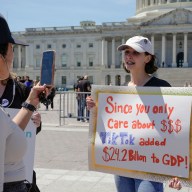A few moments after Julian Assange’s speech two days ago at the “Occupy London” stock exchange demonstration, tents popped up and London’s Saint Paul’s Cathedral courtyard turned into London’s Tahrir Square.
Yesterday, on a crisp autumn morning, demonstrators were still there, clustered in 150 tents and tarpaulin shelters outside the cathedral — a few steps away from the London base of Goldman Sachs. The plan is to remain in place “as long as they let us stay.”
That could be very long indeed, as police officers said they would not clear out the site if the demonstration remains peaceful. “Why don’t you join us?” protesters asked policemen. One said: “[I] can’t give the answer now, but I’m sure these guys will give you a better answer later.”
The atmosphere at Saint Paul’s courtyard is serene: Ideas are brainstormed and posted on boards, and daily meetings are held to discuss the protest’s next steps.
Despite their immediate goal — to raise awareness — in the long run, the “Occupy London” crowd says it wants to reshape the system through civil disobedience, seeking a better distribution of wealth.
“This campsite is not about having the same answers, but about asking the same questions,” one participant, wearing a “V for Vendetta” mask, said.
Commuters rushing to work or corporate managers on coffee breaks shuffle around — they look a little baffled, but curious. Some of them are offered a cup of tea; residents of the nearby up-market areas come down to deliver food to the field kitchen or bring donations to support the cause.
Mark, 45, working in IT, said he was “considering joining in” while going back to work wearing a suit. He has just handed out a £20 note to the info point.
“It’s not suits versus non-suits,” said Tim Sanders, a banker, visiting on a break. “This is a genuine anger for our lost generation. It is not gonna stop.”
’60s-era activist on this current movement
Metro spoke with Todd Gitlin, a professor of journalism and sociology at Columbia University. As leader of the Students for a Democratic Society, Gitlin was one of the iconic leaders of the 1968 movement.
How do these protests compare to the 1968 movement?
The current protests start from an inner core of anarchists. It has been extended by various organized groups, like trade unions. The speed at which the protests have erupted is remarkable. By contrast, the 1968 movement was founded and led by students, and it was several years before the protests broke out.
The 1968ers had a clear ideology. Do you see the same in these protests? They seem rather superficial.
They’re ideological in that their speakers are celebrities of the left. It’s rather curious that an anti-authoritarian revolt relies on outside leaders to this extent. In the 1968 movement, students formed the ideology — and the leaders were students.
Many of the people in power today are former 1968ers. What has the 1968 generation learned from its path from revolt to power?
It’s a path to power, but also a path to frustration. We reached power, but so did the plutocrats. What we’re seeing now is the first promising challenge to the power of the plutocrats.
Can protesters actually achieve anything sustainable?
The protests have rejuvenated the left.
Metro question
We asked protesters at London’s St. Paul’s Cathedral,?“Why are you protesting?”?Here are some of their responses:
Laura Lee, 23,
advice worker:
“For now we want to raise awareness, we want to say that another option exists.”
Hassan Ahadi, 50,
part-time gardener:
“We are mostly unemployed, students or people from the working class. We have different views on the solutions, but I believe the real solution is us.”
Nancy Wright, 66,
retiree:
“I just want to show that a protester is more than who’s portrayed by the media.”

















